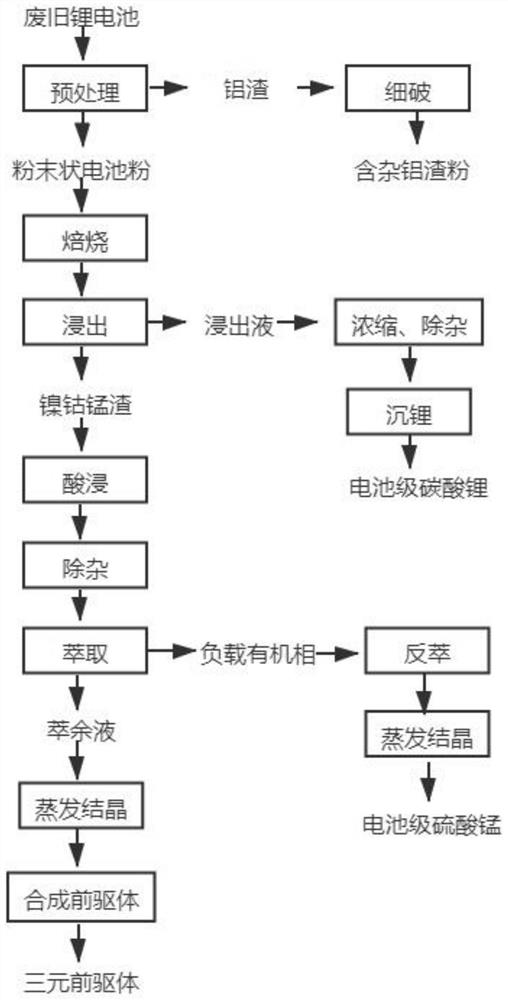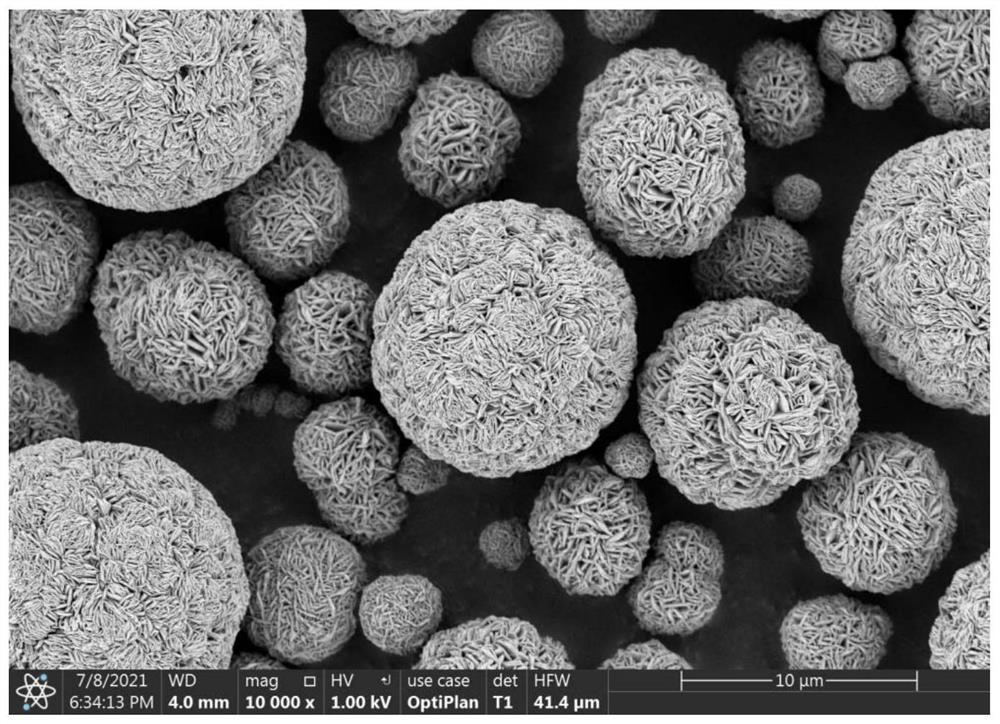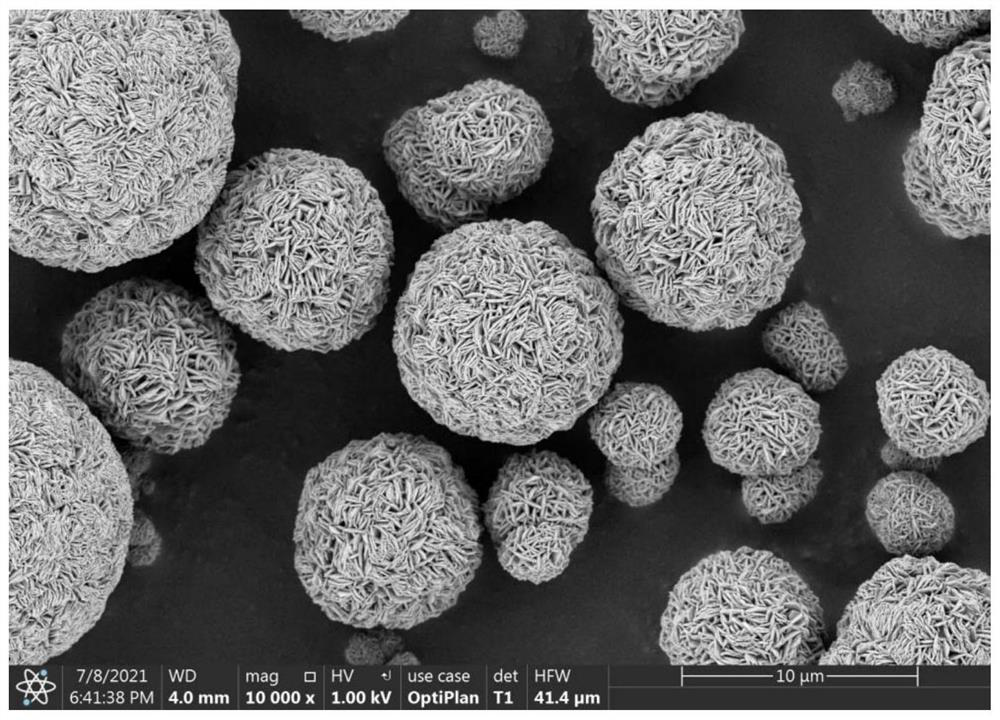Method for recycling waste lithium battery and preparing ternary precursor
A technology of waste lithium battery and recovery method, which is applied in the field of waste lithium battery recovery and preparation of ternary precursors, can solve the problems of many types of extractants, large area, long process flow, etc., and achieves large storage area. , The effect of small storage area and lower production cost
- Summary
- Abstract
- Description
- Claims
- Application Information
AI Technical Summary
Problems solved by technology
Method used
Image
Examples
Embodiment 1
[0039] A kind of recovery of waste lithium battery and the method for preparing ternary precursor, refer to figure 1 , the specific process is:
[0040] (1) Disassemble, crush, sort and sieve the waste ternary lithium batteries to obtain powdery battery powder and aluminum slag. After finely crushing the aluminum slag, pass through a 100-mesh sieve to obtain aluminum slag Powder, powdered battery powder is roasted in a nitrogen atmosphere at 600 ° C for 3.5 hours;
[0041] (2) Add the calcined battery powder to pure water with a liquid-solid ratio of 3:1mL / g to make a slurry, then add calcium chloride 1.5 times the theoretical amount required for the reaction, stir and leach at 80°C, react for 60 minutes and then filter to obtain Nickel-cobalt-manganese slag and lithium chloride solution, after the nickel-cobalt-manganese slag is washed, the lotion is merged into the lithium chloride solution, and the leaching rate of lithium reaches 97% through testing and calculation, and t...
Embodiment 2
[0050] A method for recycling waste lithium batteries and preparing a ternary precursor, the specific process is:
[0051] (1) Disassemble, crush, sort and sieve the waste ternary lithium batteries to obtain powdery battery powder and aluminum slag. After finely crushing the aluminum slag, pass through a 100-mesh sieve to obtain aluminum slag Powder, battery powder roasted in nitrogen atmosphere at 800°C for 2h;
[0052] (2) Add the roasted battery powder to pure water with a liquid-solid ratio of 5:1mL / g to make slurry, then add magnesium chloride 2.0 times the theoretical amount required for the reaction, stir and leach at 60°C, react for 40 minutes and filter to obtain nickel-cobalt Manganese slag and lithium chloride solution, after the nickel-cobalt-manganese slag is washed, the lotion is merged in the lithium chloride solution, and the leaching rate of lithium reaches 98% through testing and calculation, and the lithium chloride solution is concentrated to a lithium conc...
Embodiment 3
[0061] A method for recycling waste lithium batteries and preparing a ternary precursor, the specific process is:
[0062] (1) After the waste ternary lithium battery is discharged, it is disassembled, crushed, sorted and screened to obtain powdered battery powder and aluminum slag. After the aluminum slag is finely broken, it is processed through a 100-mesh sieve to obtain aluminum slag powder, and the battery powder is roasted in a nitrogen atmosphere at 500°C for 5 hours;
[0063] (2) Add the calcined battery powder to pure water with a liquid-solid ratio of 4:1mL / g to make a slurry, then add aluminum chloride 1.3 times the theoretical amount required for the reaction, stir and leach at 70°C, react for 50 minutes and filter to obtain Nickel-cobalt-manganese slag and lithium chloride solution, after the nickel-cobalt-manganese slag is washed, the washing liquid is combined into the lithium chloride solution, and the leaching rate of lithium reaches 98% through detection and ...
PUM
 Login to View More
Login to View More Abstract
Description
Claims
Application Information
 Login to View More
Login to View More - R&D
- Intellectual Property
- Life Sciences
- Materials
- Tech Scout
- Unparalleled Data Quality
- Higher Quality Content
- 60% Fewer Hallucinations
Browse by: Latest US Patents, China's latest patents, Technical Efficacy Thesaurus, Application Domain, Technology Topic, Popular Technical Reports.
© 2025 PatSnap. All rights reserved.Legal|Privacy policy|Modern Slavery Act Transparency Statement|Sitemap|About US| Contact US: help@patsnap.com



